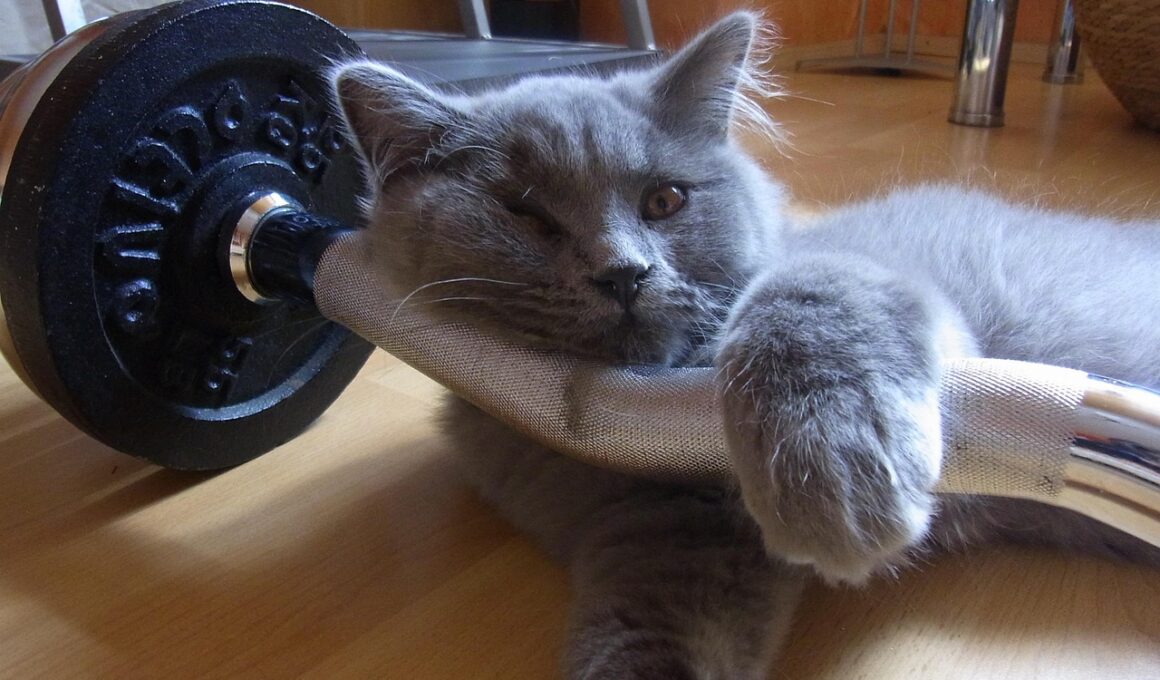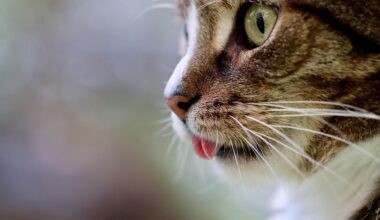Keeping a Training Log to Address Cat Anxiety Issues
When dealing with cat anxiety, it’s essential to maintain a training log. This log can help track your cat’s behavior and reactions to various stimuli. A comprehensive log allows you to identify patterns and pinpoint triggers of anxiety. Start by recording specific dates and times, giving you an organized structure to follow. Use simple headings within your log that include crucial details about training sessions, environments, and your cat’s behavior. Observing your cat’s responses after training sessions will help in understanding potential stressors. Additionally, you may want to note significant events like visitors or changes in routine. Include the duration of each training, as this impacts your cat’s stress levels greatly. Another important aspect to log is how much time your cat spends in stressful environments. If your cat thrives in certain situations, document these positive instances as well. Not only will this guide future training sessions, but it increases your awareness and timeline of the progress related to your cat’s anxiety. The log becomes a powerful tool in developing customized training for your furry companion in need of reassurance.
Creating a comprehensive cat anxiety training log provides invaluable insights into behavioral patterns. To initiate this process, it’s crucial to consistently observe your cat’s specific reactions during training and daily activities. Each observation should detail instances of anxiety, such as hiding or excessive meowing, providing context for understanding your cat’s temperament. Create categories for different aspects like noise, unfamiliar people, or environmental changes that trigger anxiety in your feline. For this task, use a simple notebook or digital tool that allows for easy editing. Prioritize clarity and organization, as this will pay off in your training planning. The more detailed your notes, the better you’ll understand your cat’s needs. Additionally, it’s beneficial to include your own feelings during each interaction while writing in the log. This self-analysis will provide insights into how your emotions may affect your cat. Include constructive goals and reflections after each session, setting you up for ongoing improvement in influencing your cat’s anxiety. As you observe what techniques work better, share insights with fellow cat owners who might face similar challenges.
Benefits of Keeping a Training Log
One significant advantage of maintaining a training log for your cat’s anxiety is the clarity it provides. This log acts as a historical reference, enabling you to track progress over time, which can be encouraging for both you and your cat. By documenting your cat’s behaviors and responses, you create a record that shows changes, whether improvements or setbacks. This evidence helps determine what strategies are effective in alleviating anxiety. Furthermore, a well-structured log allows you to share documented experiences with a veterinarian or a pet therapist. Their professional insights can become an asset in addressing specific behavioral issues or adjusting training strategies accordingly. Regularly reviewing your training log empowers cat owners to make informed decisions, fostering a supportive environment conducive to reducing anxiety. Documenting progress also establishes accountability, helping you stay committed to consistent training. Sharing progress with peers can provide motivation, as you realize you’re not alone in this journey. Additionally, monitoring your cat’s emotional and physical health through documented records heightens awareness of any health fluctuations affecting behavior.
Incorporating positive reinforcement into your training log updates is essential for cat anxiety management. Positive reinforcement builds trust and helps establish a bond between you and your cat. Each entry should not only capture challenges but also highlight successes, creating a balanced perspective. A detailed record of treats, rewards, and praise used during training allows for identifying what motivates your cat more effectively. Notes on which types of rewards work best can also guide your training sessions, adapting your approach as needed. Aim for variety in the rewards used; sometimes, a favorite treat may not produce the desired effect, and other incentives may be necessary. Additionally, logging reactions to specific rewards can help track progress, helping you note areas of improvement over time. Establishing a dynamic interaction during training sessions keeps your cat engaged, reducing the likelihood of anxiety-related behaviors. Consistency in applying positive reinforcement correlates with enhanced learning experiences for your cat. The motivation created through this process may positively shape your cat’s emotions and responses to previously anxiety-inducing situations, fostering a healthier environment.
Recognizing Signs of Anxiety
Understanding and identifying signs of anxiety in your cat is critical for effective training. Feline anxiety manifests in various ways, from changes in behavior to physical signs. Keeping an updated log allows you to notice patterns, such as excessive grooming or overreacting to sounds. Note within your log any changes in your cat’s eating habits, as reduced appetite can indicate discomfort or fear. Changes in litter box usage could also signify stress; make a record when you observe these issues. Increased hiding or aggressive behavior are strong indications of anxiety that should be logged to monitor frequency and triggers. Sounds and movements that usually do not faze your cat can develop into stressors over time and lead to anxiety. Chronic pacing or vocalization are noteworthy behaviors that signal discomfort, often appearing in moments of fear concerning the environment. Recording these signs and behaviors will significantly aid in the strategy formation to address them. Understanding what factors amplify your cat’s anxiety is essential for successful training. Consistent observation detailed in your log will empower you to shape a calmer environment for your beloved pet.
Developing a routine based on your training log observations can also significantly address cat anxiety. Routines provide stability and a sense of security for your cat. By documenting times of day when your cat is most anxious, you can create a structured schedule that gradually introduces new experiences. The repetition of positive experiences can help foster comfort, easing anxiety-related behaviors. Your training log can outline activities to be included in your cat’s daily routine, allowing you to track their effectiveness. Designate specific training times to reduce unpredictability; this improves your cat’s anticipation of events and lessens anxiety concerning unknown situations. Exhaustive notes about the reaction to new elements of a routine might inform adjustments, reinforcing the most successful elements. Cats often thrive under consistent environments, making a secure routine paramount for management. Observations related to how much time your cat spends in familiar settings versus new situations will guide your efforts in creating a balance. This stable groundwork leads to better social interactions for your feline and reduces anxiety-driven responses over time.
Conclusion
Maintaining a training log to address your cat’s anxiety is an invaluable tool for both owner and feline. This habit fosters awareness and understanding of behaviors, allowing you to chart progress successfully. Log entries that encompass triggers, responses, and successful strategies can indicate pathways for improvement. A training log also offers a historical perspective, serving as a reference for behavioral changes, both positive and negative. This resource can undoubtedly help fine-tune your training techniques, tailoring approaches to your cat’s unique personality. Emphasizing the importance of documenting experiences is essential, particularly when engaging with veterinarians or specialists who can provide further assistance. As progress accumulates in your training log, you build a stronger bond with your cat, rooted in trust and understanding. The log evolves into a shared journey, illuminating paths to achieving a more anxiety-free existence for your companion. Implementing the insights garnered through this process promises transformative changes in how your cat experiences training and everyday life. Ultimately, a commitment to consistency fosters a nurturing atmosphere where your cat feels secure and loved.


